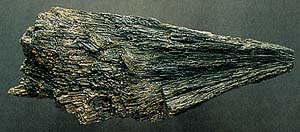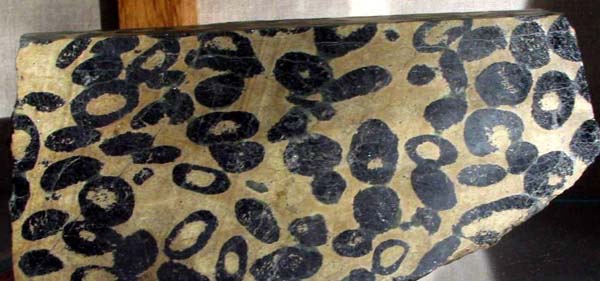Chlorites (silicates): Serpentine
 Diagnostic card.
Diagnostic card.
In the photo - fibers of serpentine-asbestos. Below: a sample of berthierine.
Mg 6 (OH) 8 Si 4 O 10
Singonia monoclinic
Hardness 2,5-4
Specific weight 2.5-2.6
Cleavage unclear
Cracked shell
Color is colorless, differently colored
Color in powder white
Shine from fat to silky
Serpentine - occurs in the form of dense aggregates consisting of cryptocrystalline mass, composes rocks (serpentinite, or serpentine). Singonia is monoclinic, forms only microcrystalline aggregates. In nature, there are three main structural forms: antigorite, or lindent serpentine (shades of yellow to yellowish-green, dim or with silky shine), lizardine, or dense serpentine, and chrysotile, or fibrous serpentine (golden with silk tint). Places of distribution: Fichtel (Germany), Carinthia (Austria), Switzerland, Ural (CIS), Canada.
Sea foam, or sepiolite - a product of weathering serpentine. Hardness 2. Density 2 (bulk density due to large porosity is less than 1). The shine is dim. White color. The line is white. It is used for the manufacture of mouthpieces and tubes. One of the most famous deposits is Eskishehir (Turkey).
Minerals of the serpentine group in composition and optical properties are similar to chlorites, but differ from them by structure. Among them there are two varieties - antigorite and chrysotile. The external appearance of the mineral and its physico-chemical properties vary greatly. There are many varieties with independent names, for example, antipers (leafy) and chrysotile (fibrous). Thin-fiber chrysotile is called asbestos.
Asbestos is a collective term for fine-grained minerals of the serpentine group and amphiboles. Anthophyllite and glaucophane are classified as amphibole asbestos. Crocidolite; Can be represented by actinolite and tremolite. The most important is refractory chrysotile asbestos. It is split into the finest fibers used to make heat-resistant and acid-resistant fabrics. Felt-like aggregates of asbestos miners are called mountain flax. Places of distribution: CIS, Canada, southern Africa.
Antigorite is represented by irregular plates of light green, light bluish-green, greyish-green and white color, combined into scaly, rather dense aggregates. Their shine is pearly or resinous.
Chrysotile is observed in the form of aggregates of light yellow, gray-green or white color, consisting of coarse flexible fibers that have a silky shine. When these fibers are combined into long soft threads of light gray color, thin and very tender, they are called asbestos, or serpentine-asbestos.
Serpentine - a group of similar in composition and structure of minerals. Green, dark, black-green, yellow, spotted (like snake skin) color. Chemical composition Magnesium oxide (MgO) 43.0%, silica (SiO2) 44.1%, water (H2O) 12.9%; Oxides of iron and nickel are often present as impurities. The shape of the crystals. Fibrous (chrysotile), leafy (antithetical). Crystal structure. Layered. Class of symmetry. Prismatic - 2 / ton. Cleavage. Mineral fibrous, leaf-like antigorite perfect cleavage. Aggregates. Thick.
The most famous of the ornamental stones in the serpentine group is apple-green bouonite with uneven dissemination of small black spots. Occasionally there is almost transparent viliamit, permeated with black inclusions. Green marbled rocks representing serpentine fusion with marble (for example, Connemara marble, verdeantik), often have the common trade name "serpentinites". They are used as a finishing material in the interior. There are deposits of similar rocks in many countries. Confusing Serpentinites and Ophiocalcites can be with greed, marble onyx and occasionally with turquoise. The product of the variation of chromous-bearing serpentinites with a pink color (to purple) is called stikhtite. He meets in Algeria, South Africa, Tasmania. Bastitis is called pseudomorphosis of serpentine in bronzitis. The mineral is characterized by a silky shine.
 Diagnostic signs.
Diagnostic signs.
Anti-corrosion is susceptible to the action of acids. Put a candle in the flame, it hardly melts around the edges. Chrysotile in hydrochloric acid decomposes to form fine silica fibers. Serpentine melts with difficulty, in a closed glass tube emits a large amount of crystallization water. Behavior in acids. It dissolves in hydrochloric and sulfuric acids.
Origin.
Antigorite in nature is very widespread. As a rock-forming mineral, it occurs in serpentinite, a metamorphic ultrabasic rock formed when peridotite rocks change. Chrysotile is found in serpentinites together with the antigorite with which it jointly performs cracks, forming a dense intertwining of fibers (sometimes several dozen centimeters thick), located parallel to the walls of the cracks (and sometimes perpendicular or at an angle).
Deposits and applications.
The classical location of the antigorite is Val-Antigorio (Ossola). The larger deposits of chrysotile are confined to Paleozoic serpentinite rocks in the province of Quebec in Canada. Smaller deposits are being developed in the USA, Russia, Zimbabwe and the island of Cyprus. In Italy, chrysotile is found in many places in the Alps, but only in some of them it can be extracted on an industrial scale.
Species.
In some iron ore deposits of sedimentary origin, berthierine, a member of the serpentine group, containing iron, both bivalent and trivalent, partially substituted by manganese, occurs.

Chrompicotite in serpentinite. Ipiaq peninsula, Azerbaijan. Photo: © А.А. Evseev.
- Ghetchellit - "New Almaden blend" - arsenide and antimony sulfide (modern sulfosol)
- Antimony is a toxic metal (semimetal) , widely used in metallurgy, medicine and engineering
- Zirconium - a rare and undiscovered metal and the most dangerous precious stone in oxide and salt
- Gold - yellow dangerous and poisonous metal of modern accurate digital and cable technologies
- Sulfur is a golden-yellow toxic substance and a sign of active volcanic activity
- Cadmium is an undisputed toxic silvery metal unknown to a wide range of people
- Lead - a toxic gray imitator of metallic silver and toxic metal blende
- Arsenic is a classic poison of medieval and modern poisoners and medicine in medicine
Poisonous and radioactive dangerous stones and minerals
** - poisonous stones and minerals (mandatory check in the chemical laboratory + explicit indication of toxicity)
** - radioactive stones and minerals (mandatory check on the standard dosimeter + ban on open sales in case of radioactivity exceeding 24 milli / g / h + additional measures of population protection)
Catalog of minerals and semi-precious stones of the world by groups
** - poisonous stones and minerals
** - radioactive stones and minerals


Comments
When commenting on, remember that the content and tone of your message can hurt the feelings of real people, show respect and tolerance to your interlocutors even if you do not share their opinion, your behavior in the conditions of freedom of expression and anonymity provided by the Internet, changes Not only virtual, but also the real world. All comments are hidden from the index, spam is controlled.